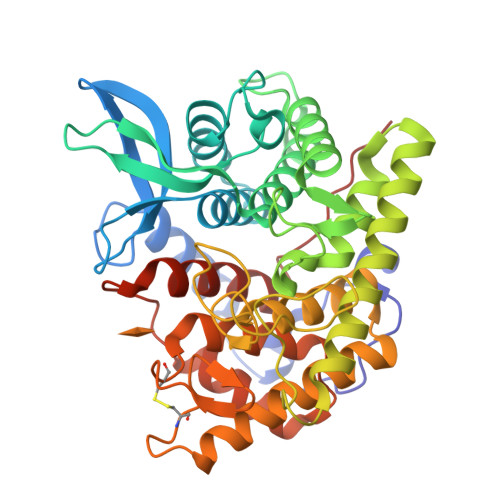The Structure of a Cold-Adapted Family 8 Xylanase at 1.3 A Resolution: Structural Adaptations to Cold and Investigation of the Active Site
Van Petegem, F., Collins, T., Meuwis, M.A., Gerday, C., Feller, G., Van Beeumen, J.(2003) J Biological Chem 278: 7531
- PubMed: 12475991
- DOI: https://doi.org/10.1074/jbc.M206862200
- Primary Citation of Related Structures:
1H12, 1H13, 1H14 - PubMed Abstract:
Enzymes from psychrophilic organisms differ from their mesophilic counterparts in having a lower thermostability and a higher specific activity at low and moderate temperatures. The current consensus is that they have an increased flexibility, enhancing accommodation and transformation of the substrates at low energy costs. Here we describe the structure of the xylanase from the Antarctic bacterium Pseudoalteromonas haloplanktis at 1.3 A resolution. Xylanases are usually grouped into glycosyl hydrolase families 10 and 11, but this enzyme belongs to family 8. The fold differs from that of other known xylanases and can be described as an (alpha/alpha)(6) barrel. Various parameters that may explain the cold-adapted properties were examined and indicated that the protein has a reduced number of salt bridges and an increased exposure of hydrophobic residues. The crystal structures of a complex with xylobiose and of mutant D144N were obtained at 1.2 and 1.5 A resolution, respectively. Analysis of the various substrate binding sites shows that the +3 and -3 subsites are rearranged as compared to those of a family 8 homolog, while the xylobiose complex suggests the existence of a +4 subsite. A decreased acidity of the substrate binding cleft and an increased flexibility of aromatic residues lining the subsites may enhance the rate at which substrate is bound.
Organizational Affiliation:
Laboratorium voor Eiwitbiochemie en Eiwitengineering, Ghent University, Ledeganckstraat 35, B-9000 Gent, Belgium.




















